Knowde Brand Summary
Identification
- Chemical Family
- Polymer Name
- Product Type
- Technologies
- Product Families
Features & Benefits
- Labeling Claims
Applications & Uses
- Markets
- Applications
- Application Method
- Plastics & Elastomers End Uses
DuPont™ Tedlar® surface protection film provides superior surface protection for a variety of materials and industries.
Whether it’s protecting people from the elements or surfaces from scuffs and stains, DuPont™ Tedlar® PVF film provides durable, long-lasting protection from the inside out. From buildings and transportation to aerospace and graphics, Tedlar® surface protection film delivers enduring value for you and your customers.
Identification
Features & Benefits
Applications & Uses
Case Study - Wembley Stadium
The stadium features over 50,000 square feet of Brett Martin Trilite rooflights that are protected with a UV blocking Tedlar® film to provide excellent resistance to weathering and outstanding chemical and pollution protection.
Case Study - Kunming Airport, Kunming, China
DuPont Tedlar® PVF coating was applied on the roofing of the S1 satellite terminal, which has a floor area of 70,000 sqm, and adopted Shanghai Simon’s PVF-coated galvanized steel solution (with the process of roll coating). PVF coating contains 100% PVF resin and no acrylic, providing better weatherability, extraordinary corrosion and UV resistance and excellent post-processing capability, which is an ideal fit to the subtropical humid climate and abundant sunshine, which prevails in Kunming.
Case Study - Martensville Athletic Facility, Martensville, Saskatchewan, Canada
When the Saskatchewan Board of Education and Prairie School District were deciding on the fastest and most cost effective approach to building an athletic facility, they turned to Sprung Structures to do the job fast and on budget. By utilizing Shelter-Rite® Architectural Fabrics with multicolored Tedlar® membranes, Sprung was able to quickly construct a beautiful exterior, allowing ongoing interior work to be protected from outside elements.
Case Study - Northwest US Office Building
DuPont™ Tedlar® will keep the Misty Gray, Sky Blue and Brite-White fabric of the building looking the same as it did on its grand opening, thanks to its weather and dirt resistance.
Case Study - TrafficWrapz™ Uses Tedlar® to Protect Outdoor Utility Boxes
TrafficWrapz™ uses Tedlar® for their city beautification projects, keeping the outdoor utility boxes more appealing and protecting them from graffiti and harsh environmental elements.
Case Study - Graphic Signage for Automotive Wrapping
Tedlar® makes an excellent protective layer for automotive wrapping. Protecting the message from fading, cracking and vandalism, allowing the brand or messaging to shine through.
Case Study - Graphic Signage in Buffalo Children's Hospital
Durability is one of many features that Tedlar® protective film has to offer. Tedlar® is often used in applications that see high human traffic, such as the art installations in patient areas at Buffalo Children’s Hospital in New York. In 2018, many of the common areas of the hospital were redesigned to include inspiring graphics for children and their families.
Case Study - Park-n-Ride Graphic Signage
DuPont™ Tedlar® film is an ideal surfacing material for graffiti resistance and protection against fading and corrosion, keeping decorative outdoor spaces looking newer longer.
Case Study - Car Repair Facility Metal Lamination
A car repair and maintenance facility in the coastal city of Chiba, Japan, located near the Nippon Steel plant, is the country’s oldest installation by Nippon Steel. Built in 1979 these photos were take in 2014 and show the roofing laminated with Tedlar® PVF film type TLY15BL3.
Case Study - Japan Railway Station Metal Lamination
This Japan Railway covered stairway at Komoro Station in Nagano, Japan is made with roof tiles specially shaped by press machines and manufactured by Nippon Steel. Built in 1994 the pictures were taken in 2014. There are two different styles of construction in the pictures, the frontside (entrance of stairway) has ceramic tiles, while the metal rooftop of the stair corridor is laminated with Tedlar® film TCC15BL3.
Case Study - Metal Lamination, Pullman Hotel, Paris
This skyscraper hotel in central Paris designed by Pierre Dufau et Associés and built in 1974 has had several different owners, from the Sheraton to the Méridien, before finally becoming the Pullman Hotel Montparnasse in 2011. What hasn’t changed is the striking 18,000 sqm façade featuring steel cladding, laminated with white Tedlar® film.
Tedlar® Case Study, Changsha Guangxiu Hospital, Hunan, China
Tedlar® was chosen for the recent renovation and expansion project at the Huhan Guangxiu Hospital. A total of 5,500 sqm of DuPont™ Tedlar® wallcoverings was used for the newly built 6-story public corridors and ward areas, including 2,000 sqm of metal laminated panels and 3,500 sqm of wallcovering.
Metal Lamination Case Study - Granite Gray Color
No rust here! Tedlar® film was chosen to protect the DuPont Yerkes plant. Tedlar® film TGY15BG3, Granite Gray was laminated to steel then formed into corrugated panels which were used to construct the plant’s façade. Even after 30 years, the plant remains protected from rust, yellowing, fading and chalking without any need to repaint.
Metal Lamination Case Study - Salem Blue Color
The Tedlar® film has resisted fading, chalking, and cracking keeping the outside of the building looking “blue” for years and years to come.
Architectural Fabric Case Study - Buffalo, NY
Protecting DuPont employees from the elements for the past 20 years, multiple colors of Tedlar® PVF film were chosen to be used on the canopy for the employee entrance. While most canopy structures would see cracking, yellowing and fading before now, the Tedlar® film has kept this structure looking like a rainbow of colors.
Architectural Fabric Case Study: Logan International Airport
The steel supported, fabric tension structure is made of Shelter-Rite® architectural fabric by Seaman Corporation. It is one of the largest frame-support fabric structures in the world and was designed by Whitney Atwood Norcross Associates. Tedlar® was chosen for its self-cleaning properties to help maintain the building’s appearance. The Tedlar® top finish can stand up to the jet fuel residue and Boston’s severe winters. So next time you're at Boston Logan, check out the bright white hangar!
Architectural Fabric Case Study: Beijing Tennis Club
In Beijing's Sun Park, three separate dome structures were built using Shelter-Rite® architectural fabric by Seaman Corporation protected with Tedlar® polyvinyl fluoride film (PVF).
Architectural Fabric Case Study: New Zealand Airport
The Tedlar® top finish would help protect the beautiful design from UV, dirt, and other elements for 10+ years. For the design, the architects converged on combination of walking canopies and large sails to illustrate Auckland’s theme “City of Sails.” The walking canopies were used to enhance and protect the building's glass and steel façade while letting in plenty of light. With the Tedlar® top finish on the canopies and sails, Auckland International Airport will be looking bright and white to greet passengers for years to come.
Metal Lamination, Manufacturing Plant, Cheonan, Korea
Aesthetic and durable can describe this new manufacturing plant in Cheonan, Korea. Steel paneling laminated with white and grey Tedlar® PVF Film grace the exterior. The build was completed in conjunction with sales partners Dongbu Steel as their first construction project using Tedlar® PVF film.
DuPont™ Tedlar® polyvinyl fluoride film provides durable, long-lasting protection to surfaces in a variety of applications including transportation, aerospace, building and construction, graphics and signage, and photovoltaics. Tedlar® film is strong and flexible, has good resistance to chemicals and aggressive cleaning agents, and has outstanding resistance to weathering outdoors including excellent hydrolytic and UV stability.
Tedlar® PVF films are made from polyvinyl fluoride homopolymer, with structure shown in Figure 1. The polymer is highly inert, making it resistant to a variety of acids, bases, solvents, staining agents, and hydrolysis. It does not absorb visible or UV light substantially and is highly resistant to photolytic degradation. It is strong, flexible, and fatigue-resistant. The polymer is made without plasticizers and therefore does not promote growth of mold and mildew and maintains its properties well over long periods of time in thermal aging. It has high dielectric strength and dielectric constant.
Outdoor weathering has been performed on Tedlar® for more than 20 years, delivering as-installed aesthetics on a variety of metal, hardboard, fabric, and plastic substrates. Pigmented film erodes gradually without any unsightly chalking. It is resistant to a large variety of cleaners and solvents, making it easy to remove environmental contamination or graffiti.
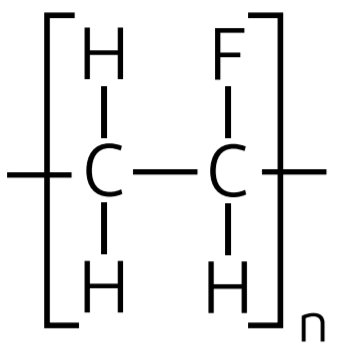
Figure 1: The structure of polyvinyl fluoride
Tedlar® PVF films are available in a variety of colors, including fully transparent and UV-blocking transparent. They are available as biaxially oriented or unoriented cast film. Typical thicknesses range from 13 to 100 µm. The surface of the film is available in the pristine state or treated to promote adhesion. In the pristine state, the film will not adhere to other materials making an excellent film for release market. In the treated state, it can be bonded using a wide variety of adhesives.
The product codes for Tedlar® films are typically an 8-digit alphanumeric code. The individual characters describe the key product parameters (color, thickness, surface treatment, gloss, and orientation), documented in Table 1. For example, TWH15BL3 is a nominal 38 µm (1.5 mil) thick, low gloss, type 3 white film with both sides treated to promote adhesion. TTR10AH8 is a nominal 25 µm (1 mil) thick, high gloss, unoriented transparent film with one side treated to promote adhesion.
The amount of orientation is a key parameter for the film. The mechanical properties of the different types of films are summarized in Figure 2. Type 3 oriented films are most commonly used due the good balance of strength, elongation, and reasonably low shrinkage. Type 1 films are typically used when high shrinkage is needed for processing the film, for example, with a high shrinkage substrate. Type 5 oriented films have lower strength and higher elongation and are used in applications where deep draw and texturing are required. Unoriented Type 8 films have the lowest strength and highest elongation and is used in applications with the highest depth of draw. Type 8 films can also be made with the highest gloss and distinctness of image for aesthetic applications.
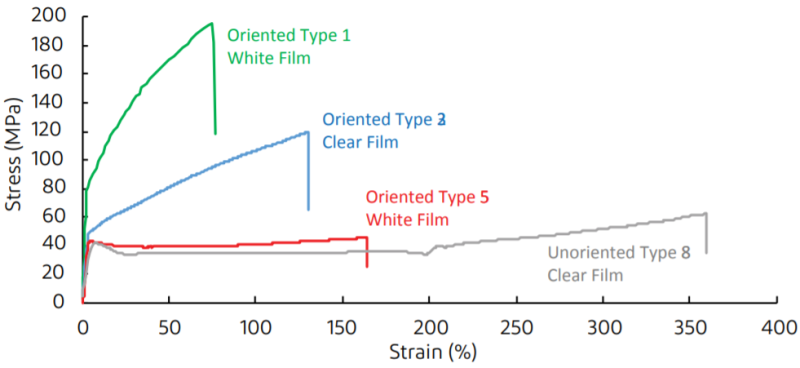
Figure 2: Typical mechanical properties of Tedlar® films
For oriented films, the gloss is controlled by additives in the film. As a result, the appearance is well maintained through processing and elongation of the film. For cast films, the gloss is typically imparted by casting on a textured web or embossing into the film during downstream processing.
Without the surface treatment, the fluoropolymer film will not adhere well to adhesives, making it useful for release applications. The surface treatment creates chemically active sites that can bond to a wide variety of adhesive chemistries.
Tedlar® PVF film performs well in temperatures ranging from approximately -70 to 105°C. It can be used with intermittent short-term peaking up to 204°C in processing or for release applications.
Table 1: Product code description for Tedlar®
| Product Code Position | Description |
| 1 | • ‘T’ for pure Tedlar® film • ‘C’ for film that is pre-coated with adhesive on one side. |
| 2-3 | Two letters indicate the color of the film. For example, WH is white, TR is transparent, etc. |
| 4-5 | Two numbers indicate the nominal thickness of the films in ten-thousandths of an inch. A film with ‘10’ is a nominal 1.0 mil (25 µm) film. |
| 6 | Surface treatment • ‘B’ for both sides treated • ‘A’ for one side treated • ‘S’ for non-treated, pristine surface. |
| 7 | Gloss level • ‘H’ for high gloss • ‘G’ for glossy • ‘S’ for satin • M’ for medium gloss • ‘L’ for low gloss |
| 8 | The orientation of the film. Types 1-5 are oriented film, and Type 8 is unoriented film. Lower numbers indicate higher orientation. |
Polyvinyl fluoride (PVF) is a fluoropolymer invented by DuPont in the 1940s.
Put into commercial use in 1961, DuPont™ Tedlar® film is a registered trademark of DuPont. For more than 50 years, Tedlar® has been widely used in various fields such as aerospace components, building façades and roofs, solar cell modules, outdoor advertisements and interior surface protection.
Tedlar® film can vary in thickness and can be laminated on a variety of materials, including metals. Compared to paint coating and other film materials, Tedlar® is made up of 100% fluorescein PVF and possesses unique properties, including excellent weatherability, ductility, durability, physical stability and resistance to many chemicals, solvents, pollutants and corrosive agents. In addition, Tedlar® film, free of plasticizers such as acrylic acid, comes with excellent aging resistance and maintains toughness and flexibility over a wide temperature range. Its dense film surface is also easy to clean; non-reactive and inert; resistant to stains and fire, as well as fading, chalking and cracking; and safe and environmentally friendly, making it ideal for a wide range of industries and applications.
Aerospace
Durable, attractive and resistant to stains and chemicals, Tedlar® film is an ideal surface protection for aerospace applications, such as aircraft interior and composite parts.
Architecture
Resistant to fading, cracking, mold and mildew, Tedlar® film can help prolong the life and aesthetics of both interior and exterior constructions in the architectural industry. It can be used for metal roofing, curtain wall and ceiling, wall exterior and interior, membrane fabric materials and highway sound barriers.
Transportation
An easy-to-clean surface that resists weathering, ultraviolet (UV) rays and harmful chemicals, Tedlar® film keeps vehicles and vessels looking their best. In the transportation industry, it is ideal for use on automobile trim, brake tube coating, fiberglass reinforced plastic (FRP) and aluminum board protection for trucks and trailers.
Signage
Long-lasting and resistant to graffiti and pollution, Tedlar® film preserves the appearance of graphics in even the most harsh environments, making it the perfect choice for various graphics’ overlay, outdoor awnings and advertising signage.
Other Applications
Tedlar® film is applicable in a wide variety of other industries. The high-performance protective film is ideal for photovoltaic module backsheet in solar panels, and for printed circuit boards (PCB), motor winding, transfer printing and composite parts in release film.
Protective & Decorative Films
High-Performance Release Films
Also: Polymers, PVF Dispersions, and Adhesives
Demonstrated Substrates & Commercial Applications
| Tedlar® Products, Application Process | Substrates that Tedlar® is Applied to… | Applications / Uses |
| Tedlar® PVF films & Adhesives, via Lamination | PET | Solar panel backsheets, automotive brightwork |
| Steel | Building roofing, siding, etc. | |
| Aluminum | Building Siding | |
| Poly ( vinyl chloride) a.k.a. “Vinyl “ | Sports domes, tents, wallpaper, signage & graphics, awnings, automotive trims, passenger rails | |
| Engineering thermoplastics (ABS, polycarbonate) | Hard signs, touch membranes, thermoformed parts, aerospace, skylights | |
| Aramid (Nomex®, Epoxy and phenolic) | Aerospace panels | |
| Fiberglass reinforced plywood panels (FRP) | Truck bodies | |
| Glass reinforced plastic panels (GRP) | Greenhouses, skylights, building panels, electric utility boxes, radome panels | |
| Scrims | Reinforcement for insulation liners in aerospace | |
| Foil | PV, pipe jacketing | |
| Urethane & Vinyl | Roofing, aerostats/blimps | |
| Dacron™ & Mylar® PET | Sailcloth protection (marine) | |
| Bitumen | Low angle roofing | |
| Tedlar® PVF film | Heat seal to create envelopes for gas sampling, acoustical wraps, insulation bags, (Bridge) cable wraps | |
| Tedlar® PVF Dispersions or Polymers, via Coating | PET | Solar panel backsheets, release films, etc. |
| PVDF | Chrome-look surfaces (automobiles, rail, appliances) | |
| Steel | Brake fluid tubing, architectural panels | |
| Fabrics | Architectural fabrics (tents, domes, etc.) |
Cleaning the interiors is a balance:
Surfaces coated with Tedlar® can make this selection easier.
All products were applied to Tedlar® PVF Film and allowed to set for 24 hours. Utilizing the following methods, all products were successfully removed from the Tedlar® PVF Film with no damage to the Tedlar® film.
| Dry Cloth Cleaning | Wet Cloth Cleaning | Mild Detergent | Solvent |
| Baby Oil | Human Sweat | Oily Pen | Ball Point Pen |
| Acid Solutions* | Urine | Mercurochrome | Surgical Fine Tip Marker |
| Acetone | Stomach Acid | White Board Marker | Permanent Marker |
| Butanone | Skin Moisturizer | Lipstick | Spray Paint |
| Ethylalcohol | Sunscreen Lotion | Ketchup | |
| Glycol | Iodine | Shoe Polish | |
| Toluene | Coffee or Tea | ||
| Red Wine or Grape Juice | |||
| Black Crayon | |||
| Mustard | |||
| Brake Fluid |
*Acid solutions include: acetic acid, 10% nitric acid, 20% hydrochloric acid, and 30% sulfuric acid
Tedlar® film is compatible with many acidic, basic, and solvent based substances that can be found in cleaning agents and disinfectants.
Surfaces protected with Tedlar® will not break down over time from continuous disinfecting.
| Disinfectants | Result |
| Clorox™ Healthcare Bleach (10%) | ✓ |
| Oxivir TB: Hydrogen Peroxide (0.5%) | ✓ |
| Virex II 256: Quaternary | ✓ |
| Hand Sanitizer: Isopropanol (70%) | ✓ |
| Oxycide (Hydrogen Peroxide and Peroxyacetic Acid) | ✓ |
Test was completed depositing 2.5ml of solution each day for 5 days on surface then cleaned afterwards to check for damage
Chemical resistance is the ability of the material to maintain its chemical and physical properties after being exposed to a chemical substance (e.g., acids, bases, solvents).
Depending on the surface material composition of furniture walls, flooring, or any surface of concern and interest, a change to the surface can occur almost instantaneously, permanently damaging the surface exposed if the surface is not adequately protected.
Tedlar® film has exceptional chemical resistance.
| Cleaners and Solvents | Result |
| Glance: Non-ammoniated cleaner | ✓ |
| Stride Citrus Cleaner | ✓ |
| Ammonium Hydroxide (10%) | ✓ |
| Acetone | ✓ |
| Ethanol | ✓ |
| Isopropanol | ✓ |
| Methyl Ethyl Ketone | ✓ |
Testing was completed using acids, bases, solvents and miscellaneous chemicals after immersion for 1 year at 25 °C and for 2 hours at boiling conditions. All samples were given an ‘E’ that denotes that there was no perceptible change of either appearance or mechanical properties after the exposure.
The following examples show how materials can be protected from stains and chemicals by applying Tedlar® protective film as the outer layer. Below Tedlar® was applied to PVC wallcovering then tested with various stains and cleaning methods.
The PVC wallcovering that is protected with Tedlar® looks brand new even after cleaning with acetone.
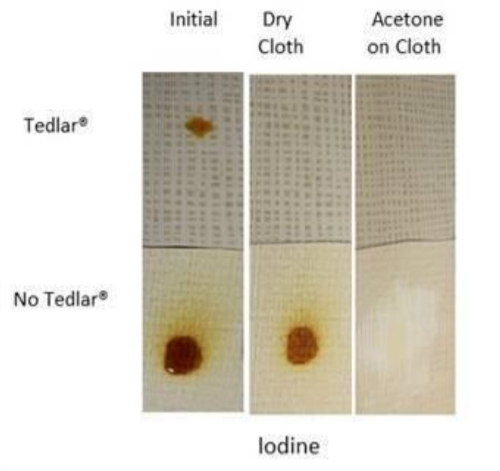
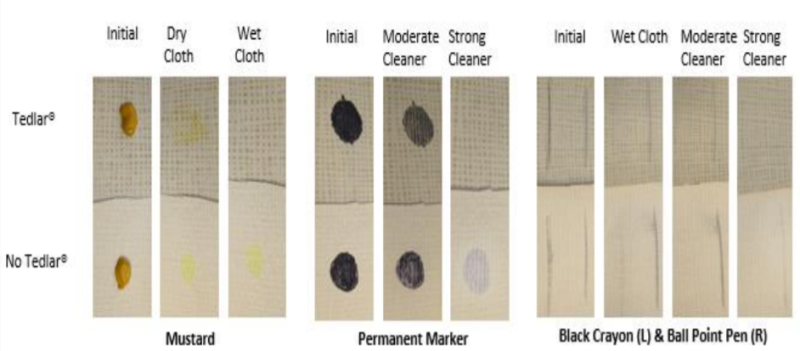
Tedlar® film is used extensively on cabin interior walls and ceilings of commercial aircraft.
Quality
Durability
Impact resistance
Aesthetics after impact
Repair after impact
Cleanability
Aftermarket costs
No Holistic paint costs
Colors
Tedlar® is available in a variety of standard colors including Clear UV Stable
Custom Colors and Pigmented Effects
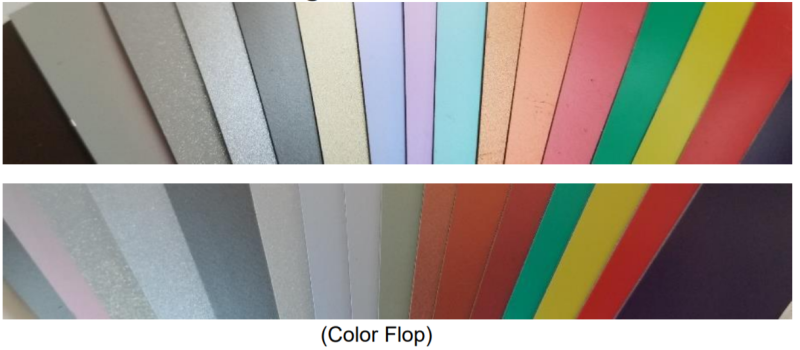
Customized color matching is possible with Tedlar®
Pearlized Tedlar®
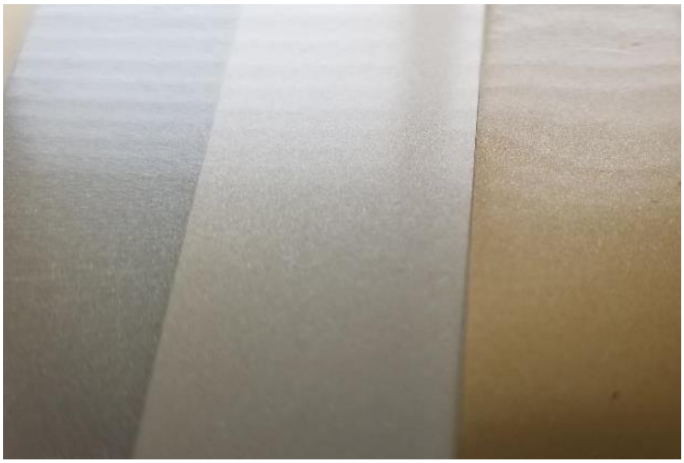
Pigments can be added directly to the Tedlar® dispersion prior to casting, creating a pearlized Tedlar® film.
Embossed Tedlar®
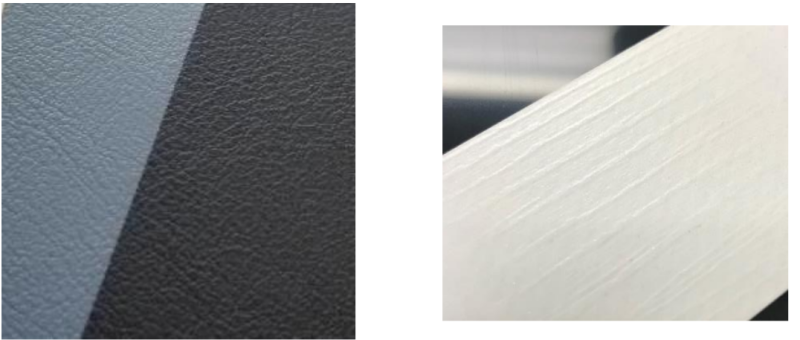
During the lamination process, transfer paper can be used to create a wide variety of textures, such as leather and wood grain effects.
Metallized Tedlar®
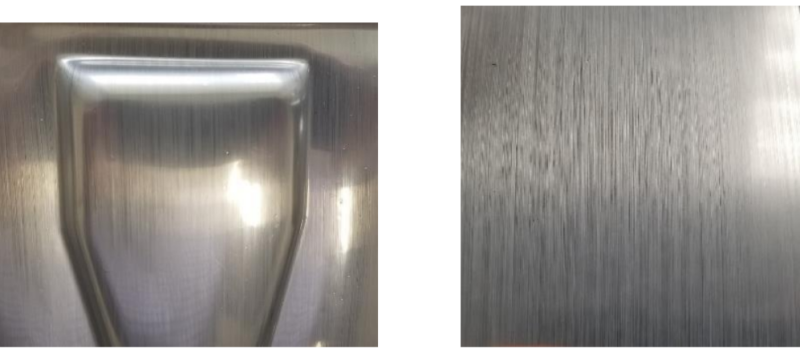
Tedlar® film can be metalized, creating stainless steel and chrome looks
High Resolution Sublimation Printed Tedlar®
Tedlar® clear film has the ability to diffuse high resolution dye sublimation inks into the film. The high resolution image is encapsulated and protected by the clear Tedlar® film.
Sublimation Printed Wood/Stone Tedlar®
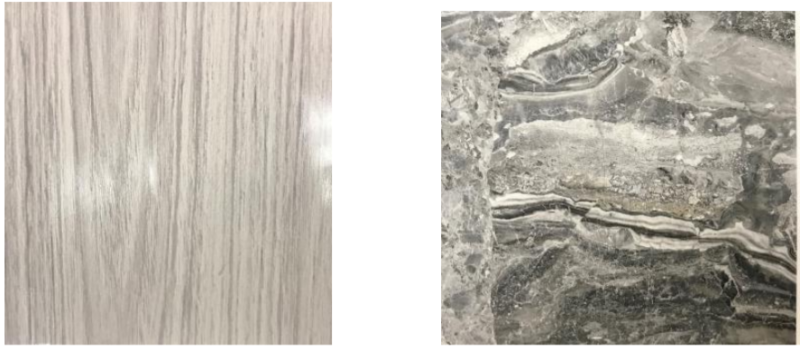
The dye sublimation process enables a wide variety of surface appearances using Tedlar® clear film. Combined with embossed textures, this technique creates a surface with a unique look and feel.
Thermoformability
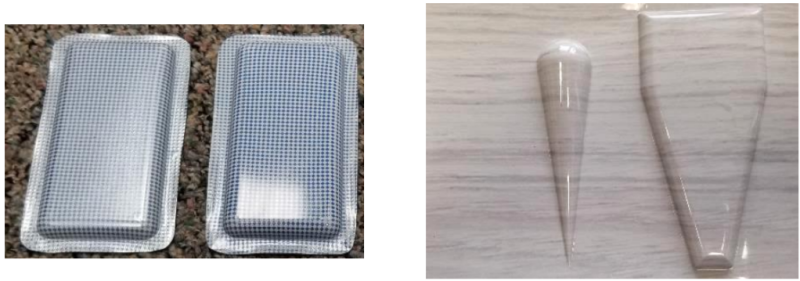
Tedlar® film is thermoformable, expanding the use of the material beyond flat surfaces.
Conductive Ink/In-Mold Printed Tedlar®
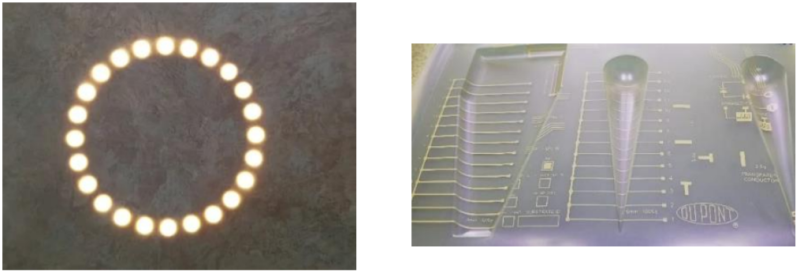
Conductive inks can be printed directly on the back of Tedlar®. This film can then be laminated and thermoformed enabling lighting, temperature, and volume controls a touch away from the end user.
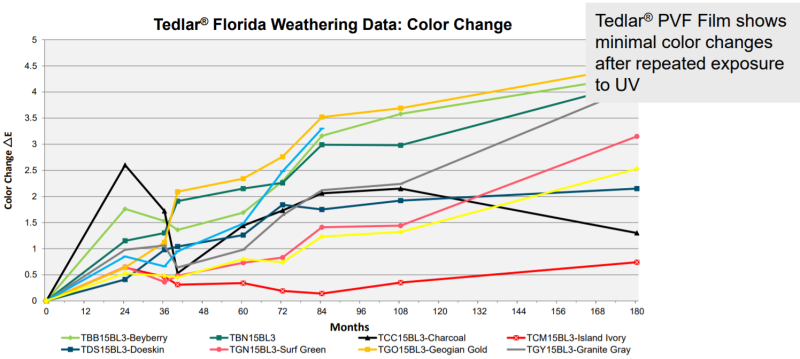
Our clear films have superior performance in properties critical for architectural protection (TAP15BM3) and graphics (TGP10BG3).
Higher retention of UV protection
Better retention of elongation
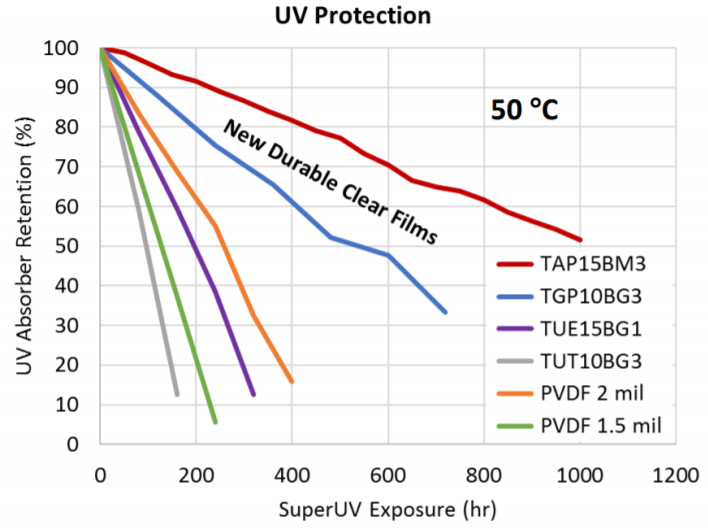
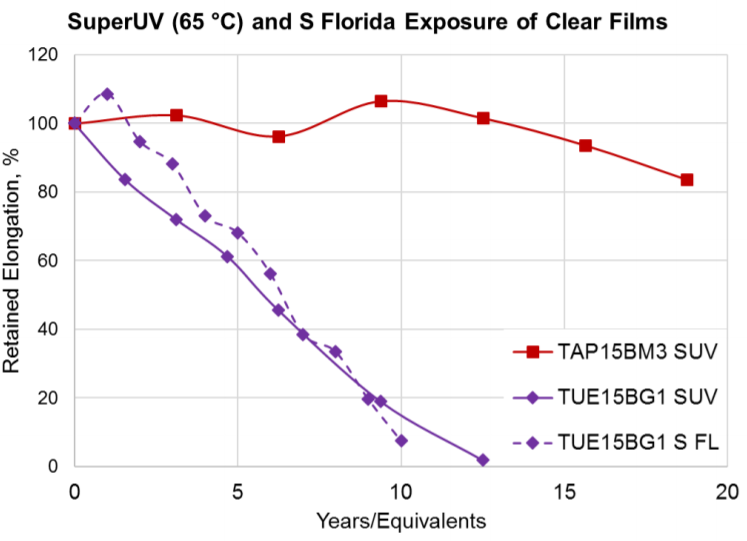
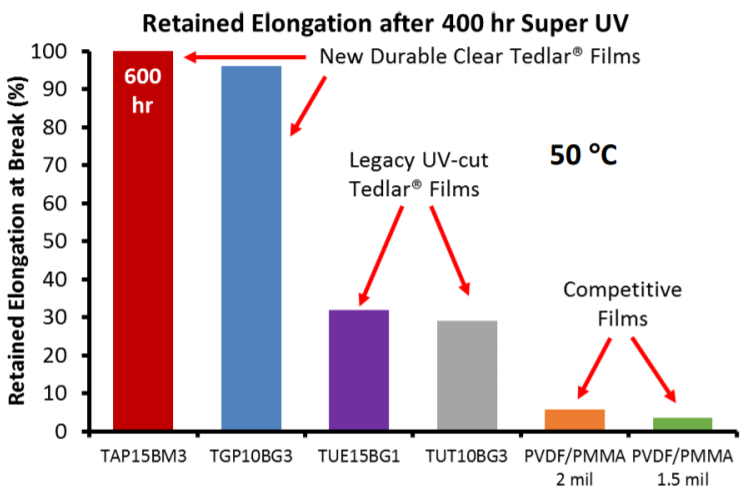
Tedlar® PVF Film vs. PVDF Coating:
Tedlar® PVF film has excellent formability, allowing for Zero TBend without mircocracking even after applying a salt spray. Polyvinylidene fluoride (PVDF) coatings crack when trying to achieve extreme bends, but the elongation properties of Tedlar(R) film allow for unlimted designs.
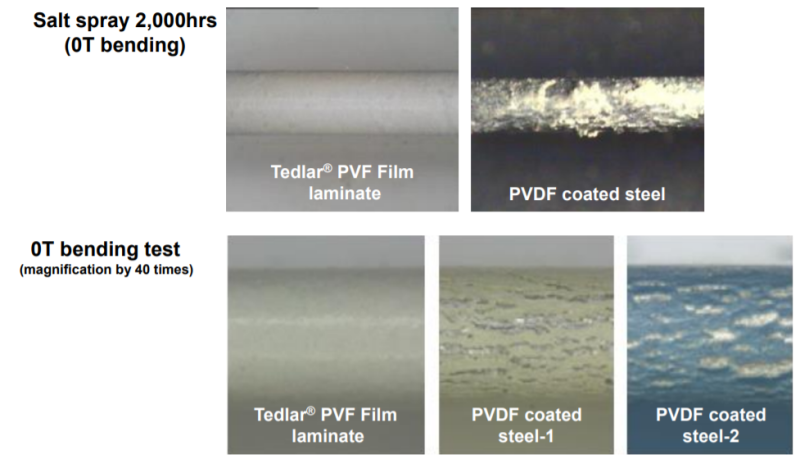
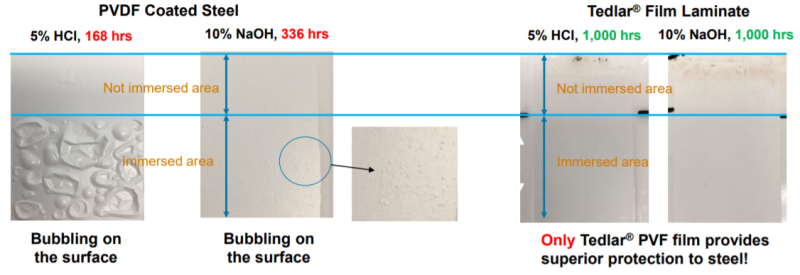
Tedlar® PVF film has excellent solvent resistance allowing it to withstand detergents and commercial grade cleaners.
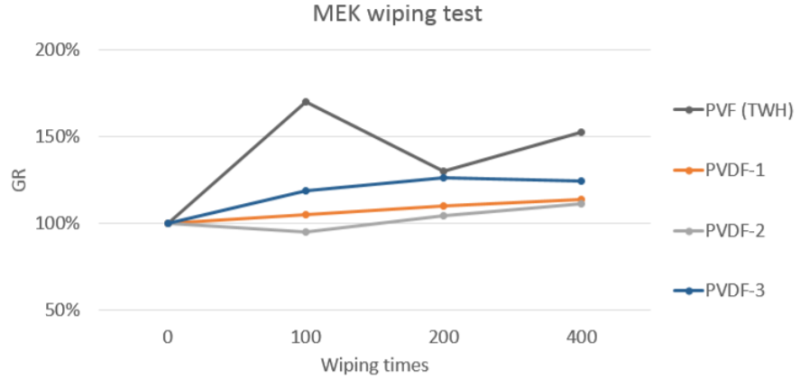
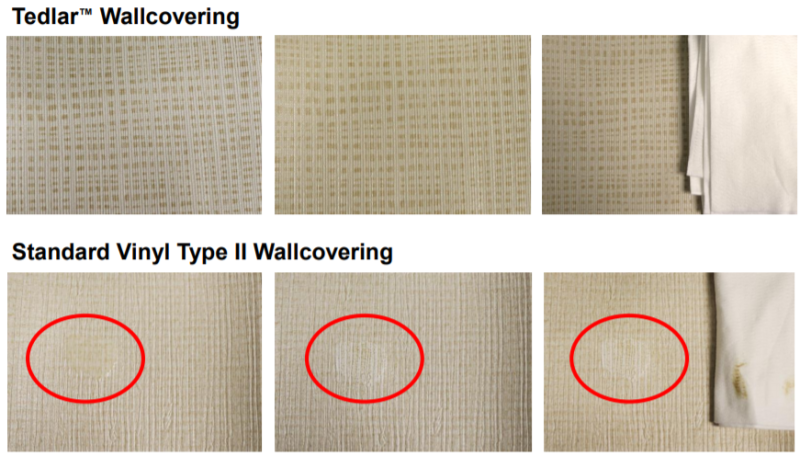
Tedlar® PVF film did not show any ghosting and was not damaged during cleaning.
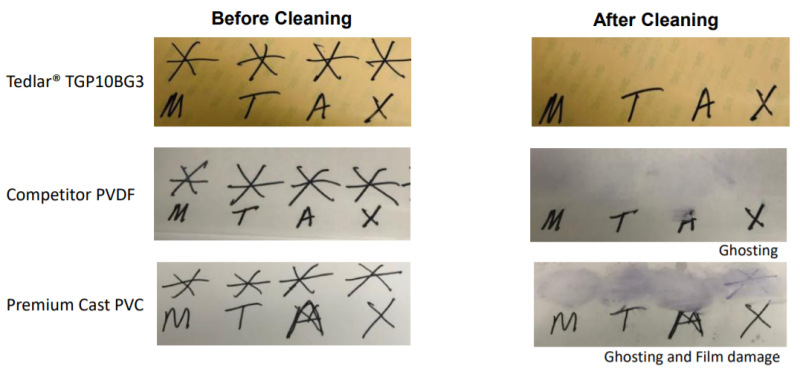
M = MEK
T = Toluene
A = Acetone
X = Xylene
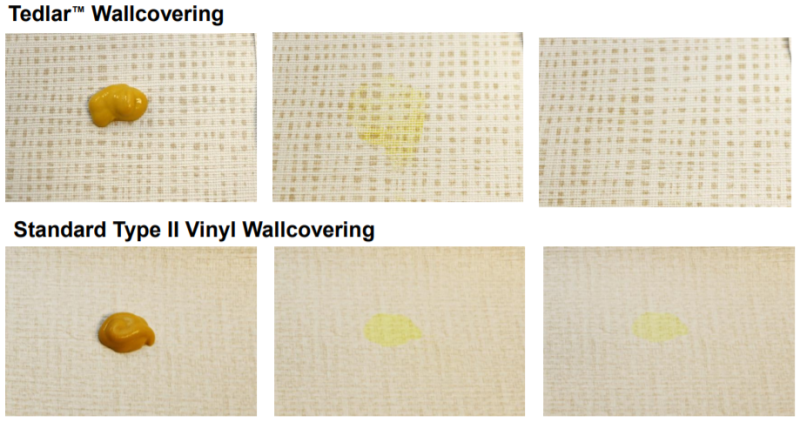

All products were applied to Tedlar® PVF film and allowed to set for 24 hours. Utilizing the following methods, all products were successfully removed from the Tedlar® film.
| Dry Cloth Cleaning | Wet Cloth Cleaning | Detergent | Solvent |
| Acid Solutions | Coffee | Ketchup | Ballpoint pen |
| Acetone | Grape juice | Black crayons | Spray paint |
| Butanone | Mustard sauce | Brown shoe polish | |
| Ethyl alcohol | Red wine | Lipstick | |
| Gasoline | Tea stains | White board marker | |
| Glycol | Worcestershire sauce | Oily pen | |
| Toluene | Chocolate syrup | Asphalt | |
| Brake fluid | Mercurochrome | ||
| Iodine | |||
| Sodium hydroxide |
Tedlar® PVM Film does not support the growth of mold, mildew. This is because Tedlar® does not have any nutrients to support growth and is chemically inert.
Tedlar® PVF surface shows mold-resistant Grade 1 after material aging.

Aging condition: 85℃/85% humidity,1000 hours
Defination of Grades:
Grade 0 = No Growth
Grade 1 = Taces of growth (less than 10%)
Grade 2 = Light growth (10 to 30%)
Grade 3 = Medium growth (30 to 60%)
Grade 4 = Heavy growth (60% to complete coverage)
Tedlar® PVF film is strong, flexible and fatigue-resistant. Its resistance to failure by flexing is outstanding. Since the surface aesthetics are imparted by the film formulation, the aesthetics do not change when stretching the film for most film types.
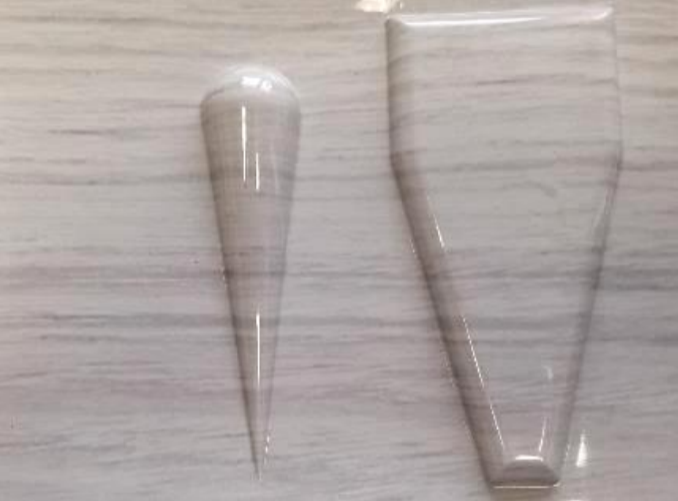
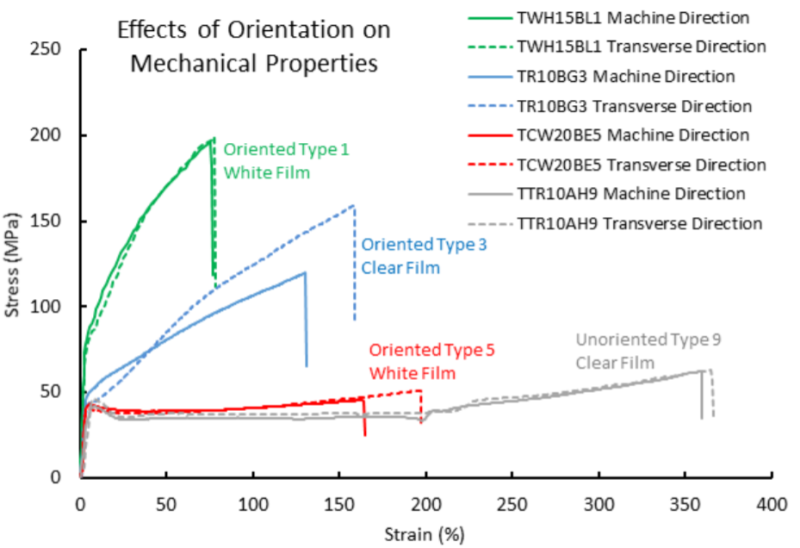
Typical stress versus strain curves for a variety of film orientations. Lower orientation causes lower strength but greater formability.
DuPont™ Tedlar® is a versatile film made from polyvinyl fluoride. For more than 60 years, Tedlar® PVF films have provided durable, long-lasting protection and timeless aesthetics to many types of surfaces that are subjected to harsh environments. Available as transparent film or in a variety of colors and gloss levels, it is typically applied to the surface of other materials to provide added durability, cleanability, and chemical resistance. Its applications span a range of industries, including transportation, aerospace, building and construction, graphics and signage, electronics, and photovoltaics.
Polyvinyl fluoride is naturally transparent and flexible, enabling its use without addition of any co-resins or plasticizers which can be susceptible to UV degradation, chemical attack, or provide nutrients to microbes. Most Tedlar® films can be stretched in any dimension to more than twice their original length without breaking, giving them superior formability, durability, and resistance to impact damage. It is formulated to provide a desired color, gloss or special functionality using only inert additives that do not sustain the life of microorganisms like mold, mildew, fungus and bacteria. When sterilization is required to remove residual microbes, the films have extremely high resistance to degradation by chemicals and disinfectants for even the most rigorous disinfection protocols.
The chemical resistance of Tedlar® originates from its highly inert chemistry. The incorporation of fluorine into the monomer unit draws electron density away from the linear carbon backbone, effectively creating stronger bonds throughout the entire polymer chain. As a result, the PVF resin does not dissolve in any known solvent at room temperature, does not absorb water, and is inert to attack by strong acids and alkalis, providing the highest level of resistance to chemicals, pollutants, corrosive agents, cleaners, and disinfectants. The chemical resistance also prevents the ingress of staining agents and enables the removal of stains or graffiti from the surface without ghosting, using a wide range of cleaners and solvents.
Tedlar® is an excellent choice for use in high traffic areas that require frequent cleaning and disinfection, such as hospitals, healthcare centers, hotels, aircraft, and other public transportation. The cleanability ensures that the intended aesthetics are maintained for many years despite high levels of use. The chemical resistance ensures that the widest variety of disinfectants can be used to kill bacteria, viruses, fungi, and other pathogens without adversely affecting the material or the surface aesthetics.
Chemical resistance refers to the ability of a material to maintain its color, gloss, dimensions and mechanical properties during and after contact with chemicals. Chemical compatibility further details the lack of chemical reaction between a material and a chemical under consideration. Tedlar® PVF films have extremely high chemical resistance and compatibility with acids, bases, oxidizers, a variety of solvents including polar, non-polar, aromatic, aliphatic, hydrocarbon and chlorinated solvents, and other harsh chemicals. Even under extreme conditions with high concentrations, extended exposure times, and high temperatures, the Tedlar® film retains all or most of its original properties and appearance. In fact, there are no known solvents for Tedlar® films at temperatures below 149°C.
Table 1 shows the resistance to acids, bases, solvents and miscellaneous chemicals after various immersion times between 25 °C and boiling temperatures. A rating of ‘E’ denotes that there was no perceptible change of either appearance or mechanical properties after the exposure, while a rating of ‘G’ denotes a slight or minimal change. While the list is not exhaustive, it shows both resistance and compatibility of a broad range of chemistries in long-term tests and tests accelerated with elevated temperature. These conditions are well in excess of many real exposure conditions and demonstrate the extreme robustness of the Tedlar® surface.
| Product | Immersion time | Temperature | Rating |
| Acids | |||
| Acetic acid (glacial) | 1 year | 21 °C | E |
| 1 month | 75 °C | E | |
| Hydrochloric Acid (10%) | 1 year | 21 °C | E |
| 1 month | 75 °C | E | |
| 2 hours | Boiling | E | |
| Hydrochloric Acid (30%) | 1 month | 75 °C | E |
| Nitric Acid (10%) | 1 month | 75 °C | E |
| Nitric Acid (20%) | 1 year | 21 °C | E |
| Nitric Acid (40%) | 1 month | 75 °C | E |
| Phosphoric Acid (20%) | 1 year | 21 °C | E |
| Sulfuric Acid (20%) | 1 year | 21 °C | E |
| Sulfuric Acid (30%) | 1 month | 75 °C | E |
| Bases | |||
| Ammonium Hydroxide (10%) | 1 month | 75 °C | E |
| Ammonium Hydroxide (12%) | 1 year | 21 °C | E |
| Ammonium Hydroxide (39%) | 1 year | 21 °C | E |
| Sodium Hydroxide (10%) | 1 month | 75 °C | E |
| 1 year | 21 °C | E | |
| 2 hours | Boiling | E | |
| Sodium Hydroxide (54%) | 1 month | 75 °C | E |
| Solvents | |||
| Acetone | 1 year | 21 °C | E |
| 2 hours | Boiling | E | |
| Acetonitrile | 1 month | 75 °C | E |
| Benzene | 1 year | 21 °C | E |
| 2 hours | Boiling | E | |
| Solvents (cont.) | |||
| Benzyl Alcohol | 1 month | 75 °C | E |
| Butyl Carbitol | 1 month | 75 °C | E |
| Butyl Carbitol Acetate | 1 month | 75 °C | E |
| Dioxane (14) | 1 month | 75 °C | E |
| Ethyl Acetate | 1 month | 75 °C | E |
| Ethyl Alcohol | 1 month | 75 °C | E |
| n-Heptane | 1 year | 21 °C | E |
| Isopropanol | 1 month | 75 °C | E |
| Kerosene | 1 year | 21 °C | E |
| Methyl Ethyl Ketone | 1 month | 75 °C | E |
| Toluene | 1 month | 75 °C | E |
| Trichloroethylene | 1 month | 75 °C | E |
| Xylenes | 1 month | 75 °C | E |
| Miscellaneous | |||
| Bleach | 1 month | 75 °C | G |
| Phenol (5%) | 1 year | 21 °C | E |
| 1 month | 75 °C | E | |
| Sodium Chloride (10%) | 1 year | 21 °C | E |
| Sodium Sulfide (9%) | 1 month | 75 °C | E |
| Tricresyl Phosphate | 1 month | 75 °C | E |
Table 1: General chemical resistance performance of Tedlar® PVF Films with regards to most common cleaners
Table 1 (cont.): General chemical resistance performance of Tedlar® PVF Films with regards to most common cleaners
In addition to the chemical resistance and compatibility, the films are impermeable to greases and oils. This makes the films easy to clean as many common staining agents will remain on the surface of the film where they can be easily removed by cleaning, restoring the original surface aesthetic completely with no shadowing orghosting.
Tedlar® PVF films do not readily absorb water and are highly resistant to degradation by hydrolysis. Even under an extremely harsh Highly Accelerated Stress Test (HAST) at 121 °C and 100% relative humidity, the films have no change in mechanical properties and no visible color change after 100hrs. In a longer-term damp heat aging test at 85 °C and 100% relative humidity, the films exhibit similar mechanical and color stability even after 4000hrs of exposure. Typical hydrolysis resistance results are shown in Figure 2.
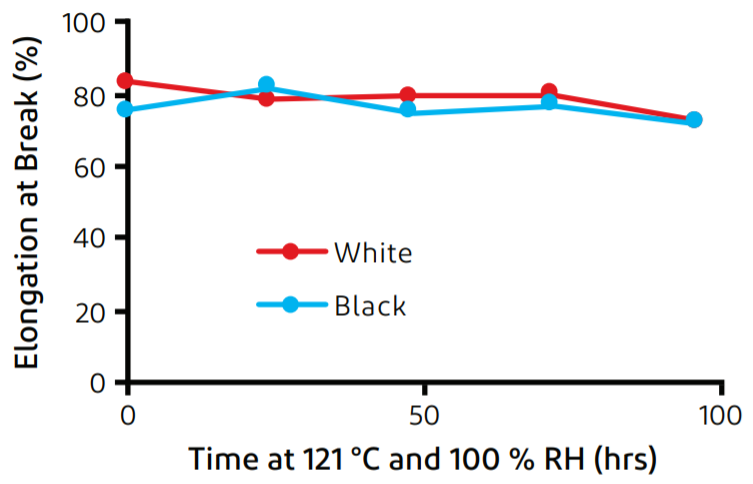
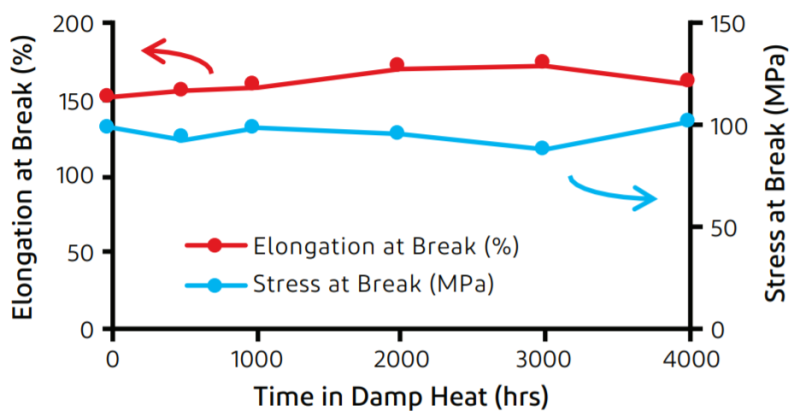
Figure 2: (left) The mechanical properties of white and black PVF films are unchanged after HAST testing at 121 °C and 100% RH for 4 days. (right) The mechanical properties of UV blocking transparent PVF film are unchanged after 6 months of damp heat testing at 85 °C and 85% relative humidity.
Figure 3 shows a photo from a test where a permanent marker was applied to a sign whose right side is laminated with Tedlar® PVF film and left side is a premium cast PVC vinyl. A 100% acetone nail polish remover was used to attempt to clean off the permanent marker. The side with Tedlar® PVF film was successfully cleaned with the acetone, while the ink penetrated the vinyl laminate leaving permanent stains. When cleaning, the stains were smeared over the surface and the vinyl eventually was irreversibly damaged.
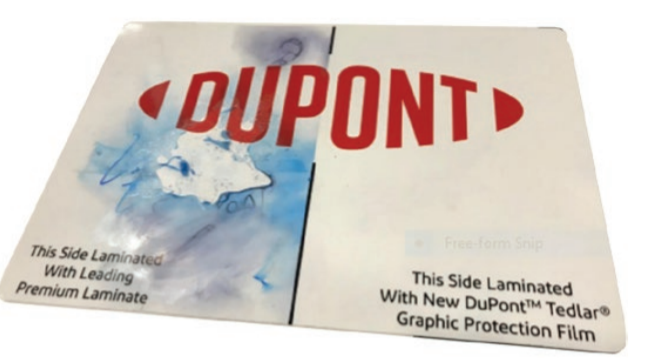
Figure 3: Extreme case demonstrating poor chemical compatibility of PVC and the exceptional cleanability and chemical resistance of Tedlar® PVF films.
While cleaning agents can easily restore the original surface aesthetic of Tedlar® films, most cleaners do not destroy viruses, bacteria, and fungal pathogens. For this, disinfecting solutions are often required. While these solutions can be highly detrimental to many materials after repeated application, causing discoloration or permanent structural damage, Tedlar® PVF films have outstanding resistance to the whole range of commonly used disinfectants.
Table 2 shows the resistance of a PVC substrate protected with Tedlar® PVF film. The disinfectants used represent the most commonly used classes of disinfectant solutions used in hospital environments. A 2.5 mL solution was deposited and left on the surface each day for 5 days. At the end of the five-day test, the surface was cleaned to remove any residues and assess the impact on the surface. A rating of ‘E’ denotes that there was no perceptible change of either appearance or mechanical properties after the exposure.
| Disinfectant | Rating |
| Clorox Healthcare Bleach Solution (10%) | E |
| Oxivir TB: Hydrogen Peroxide (0.5%) | E |
| Quaternary - Virex II 256 | E |
| JF2 Glance: Non-ammoniated | E |
| JF3 Stride Citrus Neutral Cleaner | E |
| Hand Sanitizer - 70% IPA | E |
| Oxycide: Hydrogen Peroxide + Peroxyacetic Acid | E |
Table 2: Resistance of Tedlar® PVF films to common disinfectant solutions
Tedlar® PVF film has unique properties that make it an ideal surface protection material. No other surface protective film can offer the level of chemical resistance and compatibility that Tedlar® PVF films can offer. The durability of the films will ensure that the underlying materials look good and function well for decades even in the harshest chemical environments.
Tedlar® PVF films do not support the growth of mold, mildew and other fungi, as the films do not contain a nutrient source for these microorganisms. This is demonstrated by two standard tests: ASTM G21 and UL 2824.
The ASTM G21 test is conducted by placing samples onto the surface of nutrient agar and spraying with a mixed spore suspension of five fungal strains: Aspergillus brasiliensis, Penicilium funiculosum, Chaetomium globosum, Trichoderma virens, and Aureobasidium pullulans. The samples are then incubated for four weeks and the amount of growth on the samples is observed at the end of each week. While the agar contains all the trace nutritional elements necessary to support fungal growth, it lacks a primary carbon source. For the microorganisms to exhibit substantial growth, the material under test would need to provide this nutrient source. Materials are assigned a rating each week and at the conclusion of the test, based on the criteria in Table 1.
| Rating | Observed Growth |
| 0 | No Growth |
| 1 | Trace of Growth (less than 10% coverage) |
| 2 | Light Growth (10-30% coverage) |
| 3 | Medium Growth (30-60% coverage) |
| 4 | Heavy Growth (60-100% coverage) |
Table 1: ASTM G21 rating system for fungal growth
This test was completed on a free-standing white Tedlar® PVF film (TWH15BL3) and a DuPont™ Tedlar® Wallcovering. The wallcovering consists of a transparent Tedlar® film laminated to a PVC substrate with an adhesive. Images of the results are shown in Figures 2 and 3. For each of the four weeks in the test, both samples tested achieved a rating of 1. The materials only exhibited trace growth, indicating that the materials do not contain enough nutrients to sustain substantial growth of fungus, mold and mildew.
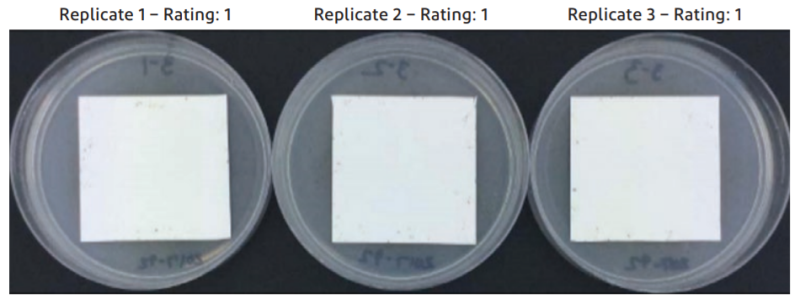
Figure 2: White Tedlar® PVF film (TWH15BL3) after four weeks of incubation in the ASTM G21 test. Trace growth was visible and additional growth was visible at 20X magnification.
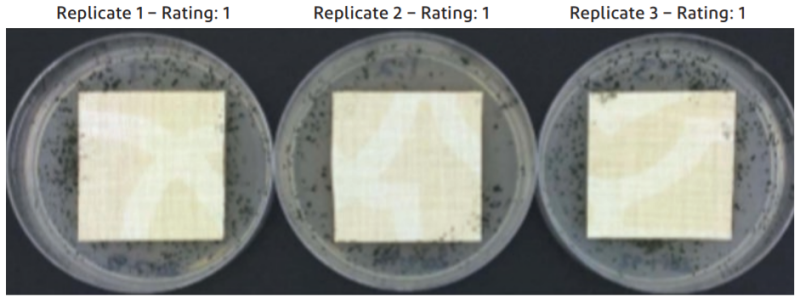
Figure 3: DuPont™ Tedlar® Wallcovering after four weeks of incubation in the ASTM G21 test. Trace growth was visible and additional growth was visible at 20X magnification.
The UL 2824 test, which meets the requirements of ASTM D6329, is a part of the annual GreenGuard Certification Program by UL that recognizes products that have superior performance for indoor air quality. This test was run on DuPont™ Tedlar® Wallcovering products as a part of an annual certification. The wallcovering consists of a transparent Tedlar® PVF film laminated to a decorative PVC substrate using an adhesive. The material was placed into a sterile Petri dish, inoculated with a known concentration of Penicillium brevi-compactum, and placed into an environmental chamber at 95% humidity at 25 °C for three weeks. A positive control sample, which is susceptible to fungal growth, was run in parallel to verify the activity of the microbes. The number of colony- forming units (CFUs) are counted at the beginning and end of the test, and a rating provided based on the criteria shown in Table 2. The DuPont™ Tedlar® Wallcovering achieved the highest rating after the three-week test, indicating that it is highly resistant to mold growth. The number of colony-forming units used to calculate this rating are shown in Table 3 for both the wallcovering and the control material.
| Rating | Interpretation | Criteria |
| 4 | Highly Resistant to Mold Growth | Log (CFU) ≤ 2.5 at 3 weeks, or Log (CFU) < 5.5 with a decrease of at least 0.5 Log (CFU) after 3 weeks |
| 3 | Resistant to Mold Growth | 5.5 ≥ Log (CFU) > 2.5 at 3 weeks |
| 2 | Susceptible to Mold Growth | 7.5 ≥ Log (CFU) > 5.5 at 3 weeks |
| 1 | Highly Susceptible to Mold Growth | Log (CFU) > 7.5 at 3 weeks |
| Material | Initial Log(CFU) | Log(CFU) after 3 week incubation | Rating |
| DuPont™ Tedlar™ Wallcovering | 2.3 | 1.7 | 4 – Highly Resistant to Mold Growth |
| Control | 2.5 | 7.7 | 1 – Highly Susceptible to Mold Growth |
Table 3: UL 2824 results for DuPont™ Tedlar® Wallcovering.
While Tedlar® PVF films do not contain nutritive components that support the growth of mold, mildew, fungus and bacteria, microbes may still find their way to the surface of the material from the environment. To eliminate these microorganisms from the surface, the surface must be cleaned and disinfected. Tedlar® PVF films have outstanding chemical resistance and durability to withstand repeated cleanings with even the harshest chemicals and disinfectants. The resistance of Tedlar® films to several common disinfectants used in a healthcare setting is shown in Table 5. The surface exhibited no cracking, delamination or changes in either color or gloss after five days of continuous contact.
The resistance to growth of mold, mildew, fungus and bacteria is complemented by the outstanding chemical resistance and ease of cleaning and disinfecting. This combines with the durability, versatility and timeless aesthetics to provide unique surface protection with unparalleled performance, indoors and out.
| Disinfectant | Rating |
| Oxycide: Hydrogen Peroxide + Peroxyacetic Acid | E |
| Oxivir TB: Hydrogen Peroxide (0.5%) | E |
| Clorox Healthcare bleach solution (10%) | E |
| Virex II 256: Quaternary ammonium | E |
| Hand Sanitizer – 70% IPA | E |
| JF2 Glance: Non-ammoniated | E |
| JF3 Stride Citrus Neutral Cleaner | E |
Table 5: Resistance of Tedlar® PVF film to common disinfectant solutions. The ‘E’ rating denotes that there was no perceptible change of appearance or mechanical properties when 2.5 mL were deposited on the surface each day for five days and cleaned off only at the end of the test.